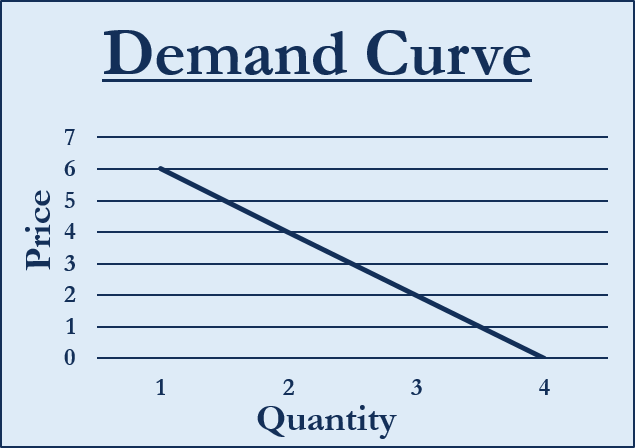To know why a demand curve slopes downwards, we need to have a basic understanding about the demand curve. So, let’s understand the demand curve.
Demand Curve
Demand curve is a graphical representation of demand for a product at different price levels. It also depicts the relationship between price and quantity. In a demand curve, the price is on the vertical axis, while the horizontal axis shows the quantity of goods.
Usually, the demand curve slopes downward, or it has a negative slope. This is primarily due to the law of demand, which states that the demand for a product rises with the fall in price and vice versa (other things remaining the same). Or, we can say that the demand curve shows an inverse relationship between price and demand.

Now, let’s look at the reasons why does demand curve slope downward.
Why Does Demand Curve Slope Downward?
The primary reason why the demand curve slopes downward is the applicability of the law of demand, i.e., demand rises as price drops and vice versa. Though the price is the primary or direct reason for the rise and fall in demand, there are several other (indirect) reasons that result in the rise and fall in demand. So, apart from the price, these are the reasons why the demand curve slopes downward. There are mainly seven such reasons that cause the demand curve to slope downwards, and these are:
Law of Diminishing the Marginal Utility
As per this law of diminishing marginal utility, the marginal utility (MU) of a product or service drops as we consume more of it. Thus, consumers will purchase more of a product or service only when the price of the product drops. However, utility from that product or service will be more when fewer units are available, encouraging them to pay more for that product or service. This proves that the demand will be more when the price drops, and vice versa. So, this is why the demand curve slopes downwards.
Price Effect or New Users
When the price of a product drops, it is possible that new consumers will start to consume it. And this would push the demand up. But, when the price of a product rises, many users will stop consuming it or reduce their consumption. This would result in a drop in demand. So, due to the price effect, consumers adjust their consumption, resulting in a downward-sloping demand curve.
Income Effect
With the drop in the price of a product, the real income of a consumer rises. This is because the user now has to spend less to buy the same quantity. The opposite is also true. This is the income effect.
So, as per the income effect, the consumer will buy more units of a commodity if the price drops. Additionally, a consumer can use some part of the extra income to buy other products. Thus, this is also one reason why the demand curve slopes downward.

Income Group
Usually, in a society, the majority of people belong to the low-income group. And this is the income group that is responsible for the downward sloping of the demand curve. Due to their limited income, this income group buys more of a product when its price drops and vice versa. On the other hand, the rich don’t have much impact on the demand curve as they have the resources to buy more or the same quantity of a product even if its price goes up.
Different Uses of a Product
If a product or service has more than one use, then it could also lead to a negative sloping demand curve. So, when the price of such a product rises, consumers will mainly buy it for the most important use. This would result in a drop in the overall demand. And, if the price of such a product drops, then consumers would use it for many purposes. This would push up the demand.
For example, if the prices of electricity rise, people will mainly use it for domestic lighting. But if the price of electricity drops, people may start using it for cooking, heating, and more.
Substitution Effect
Suppose the price of a product falls, but the price of its substitutes remains the same. In this case, the demand for the first product would increase as others may also switch to this product. Now suppose the price of a product rises, but of its substitutes remain the same. This would reduce the demand for the first product.
For example, if the price of tea drops but the price of coffee remains the same, it is possible that those who consume coffee will start drinking tea.
Tendency to Satisfy Unsatisfied Wants
Almost everyone has a demand that he or she isn’t able to fulfill due to its high price. But it is human behavior to satisfy that want when they get a chance. So, when its price drops, the consumer will try to satisfy that want increasing demand. This, in turn, leads to a downward-sloping demand curve.

